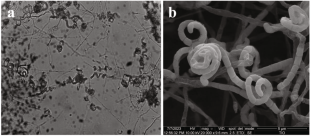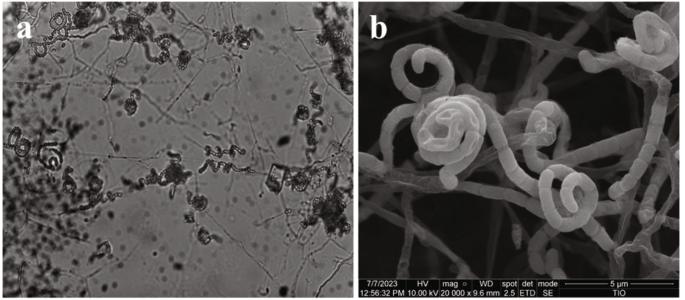从 Cathaya argyrophylla 根瘤土壤中分离出的 Streptomyces chengbuensis sp.
IF 2.1
4区 医学
Q3 BIOTECHNOLOGY & APPLIED MICROBIOLOGY
引用次数: 0
摘要
HUAS CB01T菌株是一种新型放线菌,从中国湖南省城步苗族自治县的Cathaya argyrophylla根瘤土壤中分离获得。该菌株形成生长良好的基质菌丝、扩散色素和气生菌丝,并分化出由表面光滑的棒状孢子组成的螺旋型孢子链。根据 16 S rRNA 基因序列进行的系统进化分析表明,HUAS CB01T 菌株属于链霉菌属,与婺源链霉菌 CGMCC 4.7042 T(100%)和马里安链霉菌 ICN19T(99.86%)关系密切。基于基因组的比较表明,HUAS CB01T 菌株可能与其最接近的物种婺源链霉菌(Streptomyces wuyuanensis CGMCC 4.7042 T)和马里安链霉菌(Streptomyces marianii ICN19T)存在明显差异,ANIm 和 dDDH 结果分别为 92.78% 和 45.90%,92.22% 和 43.30%,远低于建议用于划分物种的 96.7% 和 70% 临界点。主要的细胞脂肪酸包括前-C15:0、异-C14:0、异-C16:0、C16:0 和 C16:1 2OH。甲萘醌为 MK-9(H4)、MK-9(H6)和 MK-9(H8),全细胞糖类包括核糖和甘露糖。极性脂质包括磷脂酰乙醇胺、二磷脂酰甘油、磷脂酰甘油、甘露糖苷和不明磷脂。根据这些基因型和表型特征,可将菌株 HUAS CB01T 区分为链霉菌属的一个新菌种,并将其命名为 "城步链霉菌"(Streptomyces chengbuensis)。模式菌株为 HUAS CB01T(= MCCC 1K08666T = JCM 36277 T)。本文章由计算机程序翻译,如有差异,请以英文原文为准。


Streptomyces chengbuensis sp. nov., isolated from the rhizosphere soil of Cathaya argyrophylla
Strain HUAS CB01T was a novel actinobacterium which was isolated from the rhizosphere soil of Cathaya argyrophylla, Chengbu Miao Autonomous County of Hunan Province, China. The strain formed well-growing substrate mycelium, diffusible pigments, and aerial mycelium, and differentiated into spiral-type spore chains composed of smooth-surface rod-shaped spores. Phylogenetic analysis on account of 16 S rRNA gene sequence demonstrated the strain HUAS CB01T was a member of the genus Streptomyces and had a close relationship with Streptomyces wuyuanensis CGMCC 4.7042 T (100%) and Streptomyces marianii ICN19T (99.86%). Genome-based comparisons indicated that strain HUAS CB01T could be distinctly different from its closest species, Streptomyces wuyuanensis CGMCC 4.7042 T, Streptomyces marianii ICN19T, with ANIm and dDDH results of 92.78% and 45.90%, 92.22% and 43.30%, respectively, far less than 96.7 and 70% cut-off points recommended for delineating species. The main cellular fatty acids concluded anteiso-C15:0, iso-C14:0, iso-C16:0, C16:0 and C16:1 2OH. The menaquinones were MK-9(H4), MK-9(H6) and MK-9(H8) and the whole-cell sugars consisted of ribose and mannose. The polar lipids included phosphatidyl ethanolamine, diphosphatidylglycerol, phosphatidylglycerol, mannosides and unidentified phospholipids. According to these genotypic and phenotypic characteristics, strain HUAS CB01T can be distinguished and representative to be a novel species of the genus Streptomyces, for which the name Streptomyces chengbuensis is proposed. The type strain is HUAS CB01T ( = MCCC 1K08666T = JCM 36277 T).
求助全文
通过发布文献求助,成功后即可免费获取论文全文。
去求助
来源期刊

Journal of Antibiotics
医学-免疫学
CiteScore
6.60
自引率
3.00%
发文量
87
审稿时长
1 months
期刊介绍:
The Journal of Antibiotics seeks to promote research on antibiotics and related types of biologically active substances and publishes Articles, Review Articles, Brief Communication, Correspondence and other specially commissioned reports. The Journal of Antibiotics accepts papers on biochemical, chemical, microbiological and pharmacological studies. However, studies regarding human therapy do not fall under the journal’s scope. Contributions regarding recently discovered antibiotics and biologically active microbial products are particularly encouraged. Topics of particular interest within the journal''s scope include, but are not limited to, those listed below:
Discovery of new antibiotics and related types of biologically active substances
Production, isolation, characterization, structural elucidation, chemical synthesis and derivatization, biological activities, mechanisms of action, and structure-activity relationships of antibiotics and related types of biologically active substances
Biosynthesis, bioconversion, taxonomy and genetic studies on producing microorganisms, as well as improvement of production of antibiotics and related types of biologically active substances
Novel physical, chemical, biochemical, microbiological or pharmacological methods for detection, assay, determination, structural elucidation and evaluation of antibiotics and related types of biologically active substances
Newly found properties, mechanisms of action and resistance-development of antibiotics and related types of biologically active substances.
 求助内容:
求助内容: 应助结果提醒方式:
应助结果提醒方式:


